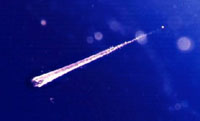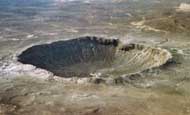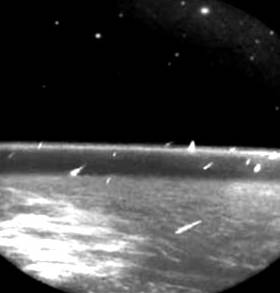
![]() Main Page
Main Page
![]() Feedback
Feedback
 The Author
The Author
 News
News
 Search
Search
 The Planets
The Planets
 Mercury
Mercury
 Venus
Venus
 Earth
Earth
 Mars
Mars
 Jupiter
Jupiter
 Saturn
Saturn
 Uranus
Uranus
 Neptune
Neptune
 Pluto
Pluto
 Dwarf Planets
Dwarf Planets
 The Solar System
The Solar System
 The Sun
The Sun
 The Moon
The Moon
 Meteors
Meteors
 Comets
Comets
 Asteroids
Asteroids
 Amazing facts
Amazing facts
 Other
Resources
Other
Resources
 Poster Store
Poster Store
 Multimedia
Multimedia
 Links
Links
 Awards
Awards
 Glossary
Glossary
 Astronomers
Astronomers
 Webrings
Webrings
 Bibliography
Bibliography
Meteors
More Images of Meteors Here |
Print this information out Here |
|||||||||||
|
Meteors are often known as 'shooting stars'. However, this description could hardly be further from the truth! They're absolutely miniscule compared to stars and the only reason they're visible is because they're so close to the Earth. What is a Meteor?
Meteors (from the Greek word 'Meteoron') are the streaks of light that are made when meteoroids, i.e. dust particles and rock fragments floating around in space, enter the Earth's atmosphere. Thousands of such meteoroids come hurtling into the Earth every day, generally at very high speeds, creating these streaks of light which can be seen by the naked eye in a clear, cloudless night sky. The vast majority of meteoroids which enter the atmosphere are burned up by the intense heat created by the friction between them and the atmosphere itself at a height of 55-65 miles above our heads, thus creating meteor streaks. Luckily for Meteor-watchers therefore, very few meteoroids are large enough for a sizeable chunk of them to make the journey to the Earth's surface. Those that do crash into the Earth's surface are called Meteorites, and if they touch down on land, will create a meteorite crater, or 'impact crater'. Craters and Origins of Meteoroids
There are a number of Meteor craters on the Earth's surface, created through the ages by meteorites large enough to reach the Earth with a considerable mass remaining. One of the most recognised is the descriptively named 'Barringer Impact Crater' in Arizona (see image), created 49,000 years ago when the Barringer meteorite (estimated to have been roughly 40 metres in diameter upon impact) slammed into Arizona at 11km/s, creating this 1.2km wide, 183 metre deep crater. Meteoroids generally come from within the Solar System, as far as we know. By analysing their composition, clues can be gleaned as to where they originated from. Such analysis has shown that some meteorites show a very similar composition to the Earth itself and the Moon, an indication that they may have originated from the moon. Others bear some resemblance to asteroids,
Meteor Showers Although they can be seen against a clear night sky the whole year round, Meteors increase sharply in number at certain times of the year; such occurances may be referred to as 'Meteor Showers'. One of the most visible and regularly occurring meteor showers, the Perseid meteor shower, takes place around the day of St Laurence, on the 12th August, give or take a day or two, depending on the year. During such periods, the Earth is passing through the tail left by a comet as it cut through the path of the Earth's orbit hundreds of years ago. The Earth moves through the tail, made of dust and other small fragments, and the particles which the Earth 'bumps into' become meteors. |
||||||||||||
Meteors Links |
||||||||||||
|
||||||||||||



